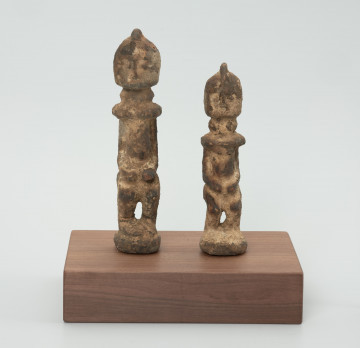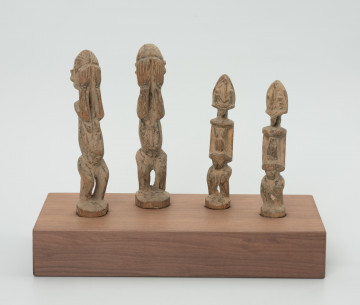
Divination set
między 1951 — 2000
National Museum in Szczecin
Part of the collection: Collection of Dogonian art
The divination set consists of two anthropomorphic figures representing a pair of early Dogon ancestors. They were carved schematically, but the gender attributes were accentuated. One figure represents a man and the other - a hermaphrodite, i.e., a bi-sexual person with marked male and female external genital organs. The somewhat geometric form of the figures, which consists of a lack of distinguishable facial features, suggests that they are endowed with the gift of predicting the future. The Dogon are an agricultural people, coppicing several species of crops. They are characterised by a complex social structure and rich spiritual culture. Particularly noteworthy is their mythology, which has long aroused the interest of many researchers, including Polish ones. The Dogon believe in Amma, the creator god who created the first pair of people. She gave birth to eight ancestors - four male and four female. These ancestors were given a unique gift of nature; they were hermaphrodites and could fertilise themselves. Of these eight ancestors, four of the male gender are considered the elders. They were Dyougou Serou (Dyungo Seru), Amma Serou, Lebe Serou and Binou Serou. The Dogon believe that each of these gave rise to one of the first four Dogon tribes and are associated with the functioning of specific social and religious institutions. Dyougou Serou is associated with the Domno people and agriculture, Amma Serou with the Dyon tribe, the ancestor Lebe Serou gave rise to the Aru and is associated with chieftainship, divination, medicine, trade and crafts, while Binou Serou is associated with the Ono people, trade and crafts. According to Dogo mythology, the brothers married their four twin sisters and populated the earth, giving birth to eighty children.
Katarzyna Findlik-Gawron
Author / creator
Dimensions
cały obiekt: height: 17,1 cm, width: 13,8 cm
Object type
sculpture
Creation time / dating
Creation / finding place
Identification number
Location / status

między 1951 — 2000
National Museum in Szczecin

między 1951 — 2000
National Museum in Szczecin

między 1951 — 2000
National Museum in Szczecin
DISCOVER this TOPIC
National Museum in Lublin
DISCOVER this PATH
Educational path